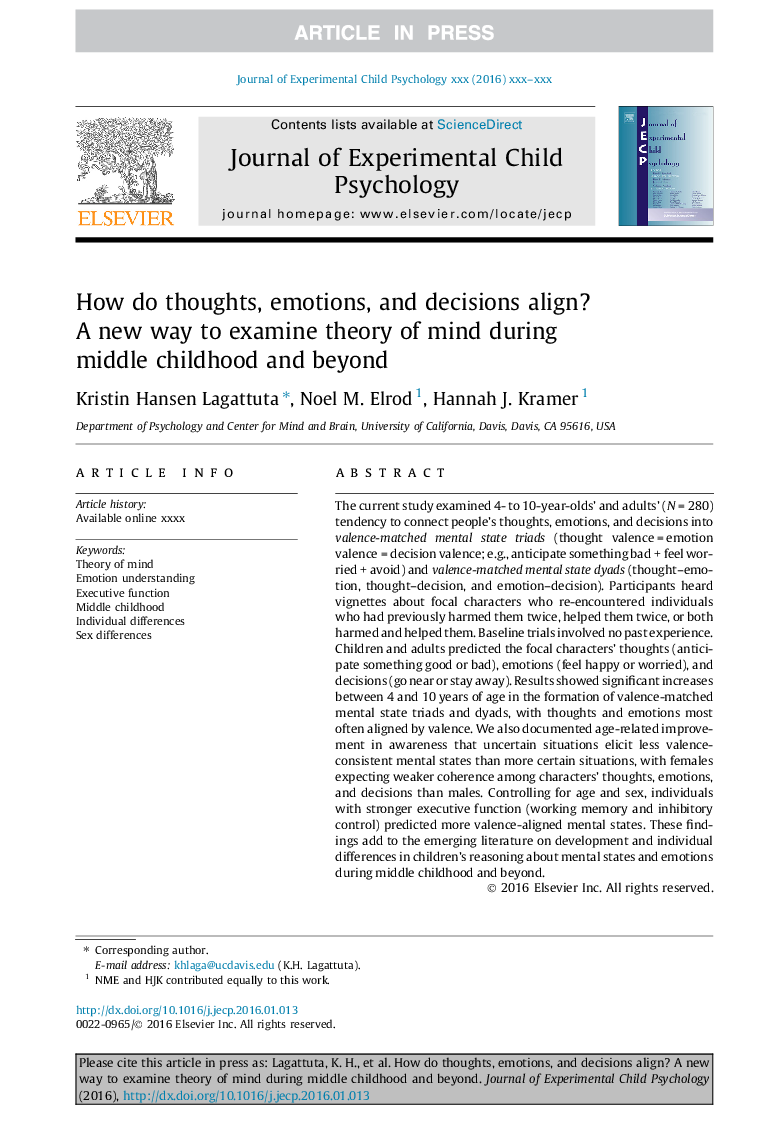| کد مقاله | کد نشریه | سال انتشار | مقاله انگلیسی | نسخه تمام متن |
|---|---|---|---|---|
| 7274615 | 1473463 | 2016 | 18 صفحه PDF | دانلود رایگان |
عنوان انگلیسی مقاله ISI
How do thoughts, emotions, and decisions align? A new way to examine theory of mind during middle childhood and beyond
ترجمه فارسی عنوان
چگونه افکار، احساسات، و تصمیم گیری ها هماهنگ می شوند؟ راه جدید برای بررسی نظریه ذهن در دوران کودکی و فراتر از آن
دانلود مقاله + سفارش ترجمه
دانلود مقاله ISI انگلیسی
رایگان برای ایرانیان
کلمات کلیدی
نظریه ذهن، درک احساسی، عملکرد اجرایی، دوران کودکی، تفاوتهای فردی، تفاوت های جنسی،
موضوعات مرتبط
علوم انسانی و اجتماعی
روانشناسی
روانشناسی رشد و آموزشی
چکیده انگلیسی
The current study examined 4- to 10-year-olds' and adults' (N = 280) tendency to connect people's thoughts, emotions, and decisions into valence-matched mental state triads (thought valence = emotion valence = decision valence; e.g., anticipate something bad + feel worried + avoid) and valence-matched mental state dyads (thought-emotion, thought-decision, and emotion-decision). Participants heard vignettes about focal characters who re-encountered individuals who had previously harmed them twice, helped them twice, or both harmed and helped them. Baseline trials involved no past experience. Children and adults predicted the focal characters' thoughts (anticipate something good or bad), emotions (feel happy or worried), and decisions (go near or stay away). Results showed significant increases between 4 and 10 years of age in the formation of valence-matched mental state triads and dyads, with thoughts and emotions most often aligned by valence. We also documented age-related improvement in awareness that uncertain situations elicit less valence-consistent mental states than more certain situations, with females expecting weaker coherence among characters' thoughts, emotions, and decisions than males. Controlling for age and sex, individuals with stronger executive function (working memory and inhibitory control) predicted more valence-aligned mental states. These findings add to the emerging literature on development and individual differences in children's reasoning about mental states and emotions during middle childhood and beyond.
ناشر
Database: Elsevier - ScienceDirect (ساینس دایرکت)
Journal: Journal of Experimental Child Psychology - Volume 149, September 2016, Pages 116-133
Journal: Journal of Experimental Child Psychology - Volume 149, September 2016, Pages 116-133
نویسندگان
Kristin Hansen Lagattuta, Noel M. Elrod, Hannah J. Kramer,
